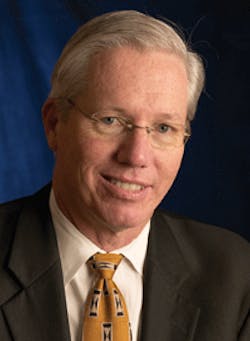Jones Lang LaSalle: Where Six Sigma Works
With the tempo of business accelerating and the drive for innovation becoming more evident, organizations across the board are transforming. Commercial real estate has no choice but to keep up. Taking note of this revolution, Chicago-based Jones Lang LaSalle (JLL) was in search of a way to stand out - a way to offer what no other real estate services firm could.
"The landscape is changing," says Richard McBlaine, president of strategic consulting and the firm's director of strategic planning. "It's not about incremental change - it's about dramatic change in the industry and in the global economy. We needed a different set of tools to help us and our clients make better decisions."
Getting Started
With the desire for progress, JLL sought a course of action that would streamline processes (both internally and externally) and create value. "In terms of speed and reduced costs, one of the things out there as a beacon was Six Sigma," says McBlaine. Sending out a team of senior consultants to study Six Sigma and its applicability to real estate, the organization started looking at the process-improvement program in 2003.
"We were doing more and more work with larger companies that had, in some cases, a very strong technical background and the need to re-engineer not only their way of doing business, but their way of doing business from a real estate perspective," says Peter Belisle, president, project and development services. The firm's interaction with clients already using Six Sigma as a methodology to re-evaluate processes was growing, and JLL was starting to field questions about using Six Sigma in real estate. "Some of our key customers were Six Sigma practitioners; they were starting to ask questions that required answers done through Six Sigma analysis. We were starting to feel a little bit behind our customers in terms of how they were thinking about processes," says Tom McCarty, executive vice president in Six Sigma practices.
in Six Sigma Practices, Chicago
At first pass, a lot of professionals viewed Six Sigma as another ISO 9000, not understanding its benefits in terms of cost and time savings, and process standardization. "Initially, the reaction from our colleagues was skepticism. But, if you're going to be a pioneer, you get used to that," says McBlaine. The team knew that no one was deliberately resisting improvement or progress - it was more likely a result of mental barriers and patterned thinking. "The work we do is somewhat of an art," says McCarty. "So, there was resistance to suggesting that any real estate service-delivery process could be mechanized and streamlined." After scrutinizing the industry itself and the services it offers to clients, the organization realized that there actually were plenty of processes to improve. "In this field, you're dealing so much with perception. Six Sigma gives you a set of tools that allows you to convert those perceptions to actual facts." The team bringing Six Sigma to the forefront just needed the rest of the organization to recognize that advantage as well.
To highlight Six Sigma's advantages and downplay anxiety, McCarty brought a real-world perspective to the new approach. As one of the early adopters of Six Sigma beyond the manufacturing world, McCarty was employed at Motorola (Six Sigma's birthplace) when the methodology was created. "Instead of coming in and making a big splash about it, I did some specific projects that really showed the benefits and how our customers benefited from working with us on Six Sigma projects. When I announced the overall program to the firm, we had already been working for 12 months on specific customer projects. We sold it totally on the benefits to our clients."
JLL's first Six Sigma project confirmed the methodology's significance and illustrated the importance of fact-based decision-making vs. perception-based decision-making. The project's purpose was to shrink the cost of processing work orders coming into the firm's Atlanta-based Facility Line, a call center that manages 300,000 annual requests. Initially, the seven-member project team assumed that there were three factors contributing to high costs: 1) the volume of rerouted calls, 2) the length of time spent handling calls; and 3) overstaffing. Using the DMAIC (define, measure, analyze, improve, control) model, one of Six Sigma's tools, the team pinpointed the variables impacting process time. Data analysis negated every one of the three supposed causes. The real cause? A considerable difference in the number of calls each agent handled per hour. The project team put new monitoring tools in place to gauge monthly agent performance and introduced a bonus system to reward productivity. Within 6 months, call-center efficiency improved by more than 50 percent; customer satisfaction increased as well. The result was an annualized cost savings of $540,000 and an increase in average hourly productivity (up from six calls to nine calls). The project was JLL's first real win with Six Sigma.
Engaging the Client
Although JLL isn't alone in its successful use of Six Sigma within real estate, the organization's actions are truly unique when it comes to applying Six Sigma among its client base. "We try to do as much work with the client as we do on our internal processes," explains McCarty. "The more the client is willing to engage, the more benefit we're able to deliver."
and Development Services, Chicago
As Steve Jones, managing director, project and development services, points out, clients typically want to accomplish three things: 1) reduce cycle times, 2) increase quality, and 3) reduce cost. "Six Sigma methodology allows you to work through all of those things," he says.
With some of its clients, Six Sigma is already part of the vocabulary. The fundamentals are there, the common language exists, and JLL can apply those processes to real estate functions since the organization already understands the associated benefits. In situations where clients are not Six Sigma practitioners, however, JLL goes about its work using Six Sigma anyway to enhance service delivery. "All they see is the result - better service delivery, changes in the way things get done, etc. It's almost 'silent' Six Sigma," says McCarty. "At other times, we have to engage the client even if they're not Six Sigma practitioners. Some projects require strong, active client representation to get the buy-in needed."
When introducing clients to the concept of Six Sigma, Jones references the use of appropriate, meaningful communication techniques as something that's helped the process along. Highlighting reductions in time or money as a result of Six Sigma is helpful to a client, but JLL actually compares those reductions to something that the client can relate to. "Our industry has a habit of saying, 'You saved X days or X dollars in construction costs.' But, the way we're able to quantify and get buy-in from clients is by speaking their language. If they sell coffee, then we say, 'You can sell X more cups of coffee in addition to what you would have originally.' It relates savings to a format that a CFO can understand. Putting a dollar figure on cycle-time reduction in terms of what that company sells vs. reduced schedule or construction-cost savings is a good thing."
Embracing Success
In everything from vertical transportation to asset management, JLL has applied Six Sigma to achieve savings, improve customer satisfaction, and make smart decisions. The firm's work on the Orange Bowl redevelopment project is proof positive. Knowing that inefficiency can literally take over a large development project, JLL set up a series of subcommittees concerning public relations, financial reporting, design and construction, land, operations, etc. "We were looking for ways to pass information along, but avoid those classic project-development meetings where 50 people show up once a week and sit through 6 hours of meetings when they're only needed for 10 percent of the meeting," says Belisle. "In any large development project, information flow, dissemination, and collection across such a broad consultant team takes up a tremendous amount of time. Via Six Sigma, we developed a project charter that helps us be more efficient when running the series of 10 to 20 meetings each week that are involved with a $300 million project. We did a process overhaul, and the maximum bang for the buck came out of that."
Janet Kissel, senior vice president, describes a recent asset-management project as another Six Sigma triumph. Searching for a way to globally manage all of the facility assets (furniture, equipment, carpet, etc.) on the books for a client, the JLL team used Six Sigma to identify $135,000 in assets that shouldn't have been on the books (and that the client shouldn't have been paying taxes on). "The net result was the development of a standard global process for inventorying and tracking assets. There were actually $135,000 in net cost reductions and another $30,000 in property tax and insurance savings, all within 6 months," explains Kissel.
Another Six Sigma project for a JLL client entailed the re-engineering of a process for inspecting and maintaining pressure vessels and relief valves. Driven by JLL, the goals of the project were to reduce costs, increase labor efficiency, and achieve compliance with requirements. "We achieved all three of those with Six Sigma," says Kissel.
On a separate project, instead of JLL spearheading efforts, the client chose to take a very aggressive energy-management approach. "In support of that approach, we [instituted] a site-audit process across the entire portfolio. We systematically gathered a broad range of energy-consumption data; we analyzed the data and developed action plans for driving consumption down." The result? The establishment of an annual audit process and a number of improvement projects that will reduce energy consumption for the client over the next 5 years.
Global Energy Services, Chicago
Another interesting Six Sigma case study involves energy management as well. Knowing that energy usage was high for a particular client, John Schinter, director of global energy services, and his team did some investigating and learned that the employees inside the client's buildings weren't focused on building-related issues - they were focused on their own daily tasks. "Everyone relied on [the employees] to make sure that the lighting systems were off or that air-conditioning systems were set back. That just doesn't work," explains Schinter. Using data gathered from Six Sigma processes, his team was able to narrow in on the fact that building systems weren't being shut down at night. To minimize energy use, the firm was looking for a "zero-impact" routine for the employees, taking away their responsibilities of shutting down or setting back equipment. "We ended up putting programmable thermostats in so that air-conditioning systems were set back at night. On the lighting side, we installed occupancy sensors. In many cases, we actually put in new lighting systems to reduce energy consumption. We ended up saving about $5 million across the portfolio, and it's been sitting like that for years. There was an incremental reduction of $5 million, and it represented a net 8-percent reduction across all those properties. Now, they sustain that every year."
Six Sigma has also enhanced JLL's leasing procedures. Identifying a number of tasks that were currently being handled by multiple people (but could be handled more appropriately by just one individual), the firm reorganized and now holds one person accountable for all sides of a lease, cutting down on communication time and speed of delivery by 20 percent.
Expert Advice
The improvements that Six Sigma has brought to JLL have prompted the organization to make certain this methodology is recognized and used when applicable. "One of the big misconceptions about Six Sigma is that it's simply a statistical-based approach and only about elimination of errors or defects. The biggest mistake executives make when they get turned off by Six Sigma is categorizing it as simply that - a statistical-based approach - and dismissing it," says McBlaine. "Six Sigma has a lot to offer all kinds of businesses, not just manufacturing. It's not just about eliminating defect, but it's about using a set of tools and architecture to make better decisions." It can also provide a realistic way to achieve desired results. As an example, Schinter points to his specialty: energy. "Every major corporation is faced with environmental sustainability as an initiative. Even though there's a regulated requirement for reducing greenhouse-gas emissions, some property managers don't have the means to do it. They have to do it, but they don't know exactly how to do it. It's very difficult to achieve improvement if you don't use a process like Six Sigma; everybody just accepts it as an expense that fluctuates and thinks that nothing can be done. In reality, you can have a 15- or 20-percent energy reduction by using Six Sigma." Before writing Six Sigma off as something that's not right for your organization, JLL experts offer some words of wisdom.
Don't give in to the curse of "good enough." mprovement is always possible, no matter how competent and well-organized your team is. Are you taking on strategies to reduce water consumption by 10 percent? You could decrease that consumption by 12 percent. Averaging 15 days to turn around lease documents? You could shrink that average to 13. As Kissel points out, you shouldn't focus on doing an "okay job" on several things; focus on high-impact items that will drive significant improvement in a 3- to 6-month timeframe.
Educate the C-suite. "When you see the companies that are doing Six Sigma successfully, it's a top-down approach," says Jones. If top-level management supports it, they can start to push it down through the other channels of the organization.
Start small; achieve quick wins. No matter what you say or do, your colleagues probably won't accept Six Sigma unconditionally as a way of doing business (at least in the beginning). As opposed to making an out-of-the-blue proclamation about using Six Sigma, select a problem that's small enough to tackle and see quick results. "Quantify an area of pain, evaluate it, understand the issues, and discuss how you can create a solution," says Jones. "That way, you have a success story built around Six Sigma already."
Pick the right project. Disappointment with Six Sigma occurs when it's used to address problems without any bearing on an organization's strategy or mission. Apply Six Sigma to things that matter most. "From a list of 20 projects, narrow it down to half a dozen projects or fewer that you could drive improvement on in the next 3 to 6 months," advises Kissel. These experts suggest customer approval and work-order management as two processes that almost always result in a superior outcome.
Be committed. The professionals at JLL emphasize that a 2-year commitment is essential in getting a flourishing Six Sigma program off the ground. "It takes time for it to become ingrained as the way you work," says McCarty.
The Final Word
Strategic Consulting President of
Strategic Planning, Chicago
The last few years have taken decision-making to a whole new level for Jones Lang LaSalle. "It just becomes a way in which you do business. When an issue comes up, we quickly go to the facts and tools we can use with Six Sigma to make better decisions," says McBlaine. "This kind of decision framework and architecture is being embedded more and more in the firm every day."
Helping the organization focus on fact-based management and decision making, Six Sigma has resulted in 30-percent improvement in project cycle times, 40-percent improvement in call-center productivity, and 25- to 30-percent improvement in work-order management labor requirements, to name just a few recent accomplishments. "There are certain problems facing property managers and engineers that just seem to never go away," says McCarty. "We've been able to use Six Sigma to solve some of those problems that were unsolvable."
Leah B. Garris ([email protected]) is senior associate editor at Buildings magazine.
All Photographs: Mike [email protected]





